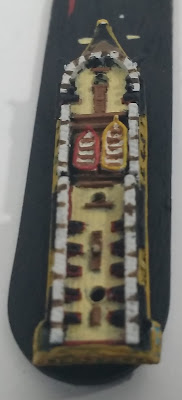I will be attending a convention called Texas BROADSIDE! 2017. This convention is actually held on board the USS Texas. She is the last remaining WWI superdreadnought in the world, and fought in both WWI and WWII. During WWI, she was part of the Grand Fleet in the Sixth Battle Squadron, which was made up of US ships. During WWII, she was at Operation Torch, Normandy, Cherbourg, southern France, Iwo Jima and Okinawa. She was also the first US battleship to become a permanent museum ship.
The convention was started in 2011, and has been held every year since then. All the money we raise from the convention goes to the ship for preservation and restoration efforts. Even if you can't make it to the convention, I urge you to visit the website (http://www.beerandpretzelwargaming.com/texas-broadside.html) and purchase yourself a shirt or something; it's for a good cause. Below is the press release for the convention. PS: If you think other people might be interested in this, PLEASE share this post far and wide. USS Texas was commissioned in 1914, so is now 103 years old and in need of lots and lots of tender loving care and money (especially money).
“Texas BROADSIDE! 2017”
– October 13 thru October 15, 2017
In
cooperation with the Battleship Texas Foundation, Houston Beer and Pretzel
Wargaming will host its 7th annual wargame convention aboard the
Battleship TEXAS, Friday, Saturday, and Sunday, October 13th thru
October 15th 2017.
Inspired by the National WWII Museum’s past “Heat of Battle” wargame conventions, “Texas BROADSIDE!” uses wargaming as a means to educate the visiting public about the history of armed conflict and features local-area gamers playing board and miniature games aboard the USS TEXAS. These games simulate various battles on land, at sea, or in the air, drawn from conflicts throughout world military history, from ancient through modern times.
Inspired by the National WWII Museum’s past “Heat of Battle” wargame conventions, “Texas BROADSIDE!” uses wargaming as a means to educate the visiting public about the history of armed conflict and features local-area gamers playing board and miniature games aboard the USS TEXAS. These games simulate various battles on land, at sea, or in the air, drawn from conflicts throughout world military history, from ancient through modern times.
Again this year, Houston Beer and Pretzel Wargaming will be running free-to-the-public
opportunities throughout the weekend for young visitors to the Battleship TEXAS
to learn how to constructively play with “toy soldiers”, while receiving an
introduction to the wargaming hobby.
Lunch time
lectures by TPWD staff, noted military, military history, and/or wargaming
hobby speakers will also be featured. Several modeling and game hobby vendors will
also be on site, where wargamers in attendance, and the general public, can
shop for and buy war books, games, terrain, and model kits and modelling
supplies.
The games begin at 10:00 am
each day and conclude at 7:00 pm. All games will be played in the public
areas of the ship, so visitors to the TEXAS can watch the gaming and ask
questions of the gamers. Participating in one or more games requires the
purchase of a separate special event ticket. All proceeds from the event
will be donated to the Battleship Texas Foundation to assist in their
ongoing restoration efforts. Details can be
found here: http://txbroadside.com
Houston Beer and Pretzel
Wargaming is a group of gamers who meet monthly, to share in simple, fast, and
fun wargaming, amongst friends, whilst enjoying a good meal. They organize and run Texas BROADSIDE! each
year to provide a unique opportunity for local wargamers to play aboard a
historic treasure, to educate the public about military history through
wargaming, to publicize the wargaming hobby, and as a fund raiser for the
Battleship Texas Foundation.
For more information please contact Andy Bouffard, Director of
Texas BROADSIDE! 2017 at
(713)548-4944 or email him at mailbox@txbroadside.com
















